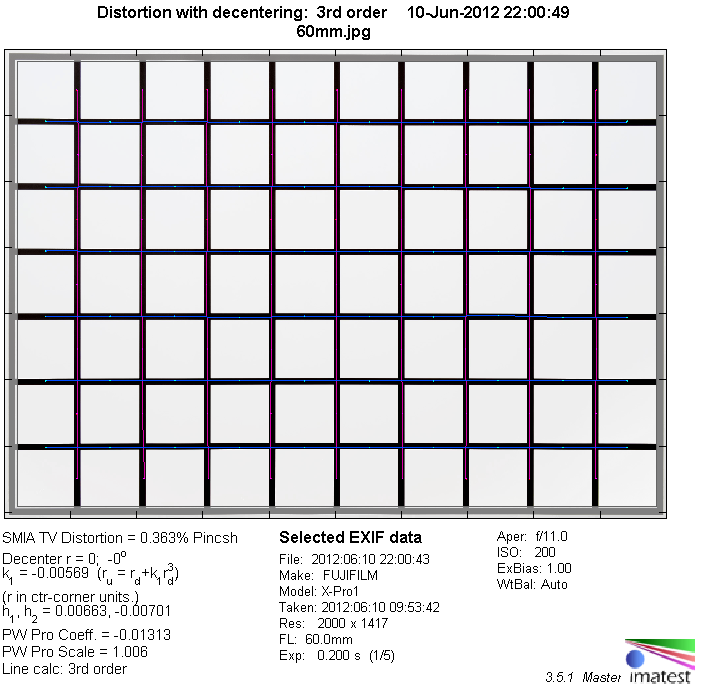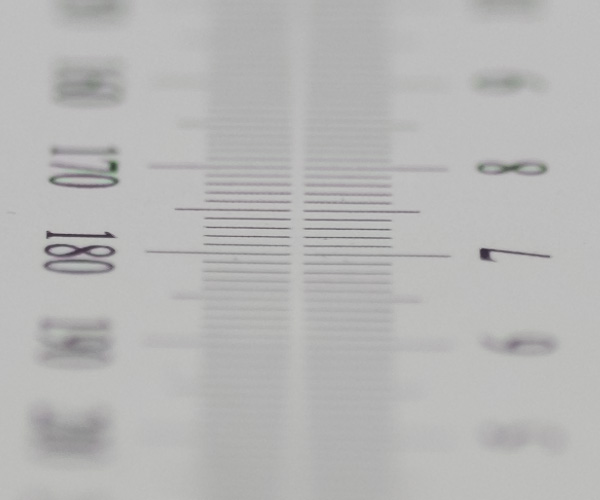|
Fujinon XF 60mm f/2.4 R macro (Fujifilm) - Review / Test Report - Analysis |
|
Lens Reviews -
Fujifilm X
|
|
Page 2 of 3

Distortion
As already mentioned in our previous X-mount review, the system takes advantage of a digital auto-correction either by the camera (JPEG) or during the RAW-conversion (Fuji RAW converter). The pincushion distortion is reduced to just 0.36% which is pretty much negligible by real world standards. However, the original distortion (as produced by third party RAW converters) is significantly worse at about 2.3% - this can be visible in certain scenes.
Auto-corrected:
 The "RAW" distortion:
The "RAW" distortion:

Vignetting
The Fujinon XF 60mm f/2.4 R macro shows some vignetting at max aperture. A light falloff of ~0.8EV (f-stops) can be visible in certain scenes but this is certainly far from being extreme. The issue is basically negligible from f/3.2 onward.

MTF (resolution)
The Fujinon produced a highly impressive resolution characteristic in the MTF lab. The center performance is already excellent at max aperture and the outer image region reaches good to very-good results. The peak performance is reached around f/4 where the borders scratch an excellent rating and the extreme corners are easily very good. The image quality remains on a very high level till f/8. At f/11 diffraction effects start to have a higher impact but the quality still remains pretty good. f/16 produces usable results but you should avoid f/22 due to very pronounced softness - this is a physical limitation and not a lens problem. The focus field is very flat which is typical for most macro lenses.
The centering quality of the tested sample was excellent.
The chart has been updated compared to the initial version. We have moved to CaptureOne for RAW processing. However, the differences are rather marginal.
Please note that the MTF results are not directly comparable across the different systems!
Below is a simplified summary of the formal findings. The chart shows line widths
per picture height (LW/PH) which can be taken as a measure for sharpness.
If you want to know more about the MTF50 figures you may check out the corresponding
Imatest Explanations
Chromatic Aberrations (CAs)
Lateral CA (color shadows at the image borders) are very well controlled with an average pixel width between 0.25-0.6px. This is nothing to worry about.

Bokeh
A very important aspect of a large aperture and/or macro lens is the quality of the bokeh (rendering of the out-of-focus blur). The Fujinon is certainly capable of producing very good results here.
Both the background (to the left below) and foreground blur (to the right) is very smooth and buttery which is a seldom characteristic.
 Out-of-focus highlights have a slightly uneven inner zone. There's a marginal outlining effect here at f/1.4 which gets emphasized the more you stop down. The highlights are circular in the image center but "cat’s eye"-shaped towards the borders (a vignetting effect). Stopping down improves the cat’s eyes towards a circle and the circular shape remains intact till f/5.6 where you can start to spot traces of an edgy aperture shape.
Out-of-focus highlights have a slightly uneven inner zone. There's a marginal outlining effect here at f/1.4 which gets emphasized the more you stop down. The highlights are circular in the image center but "cat’s eye"-shaped towards the borders (a vignetting effect). Stopping down improves the cat’s eyes towards a circle and the circular shape remains intact till f/5.6 where you can start to spot traces of an edgy aperture shape.

Bokeh Fringing / Longitudinal Chromatic Aberrations (LoCA)
Bokeh fringing is a common issue with fast glass. It's visible as halos of different colors in out-of-focus areas - magenta (red + blue) in front of the focus point and green beyond.
The Fuji lens shows a slight bokeh fringing at large aperture settings which can of be reduced by stopping down. The effect remains marginally visible f/3.2 but it is basically gone from f/4 onward.
|
Move the mouse cursor over the f-stop marks below to observe the respective LoCAs
|
| f/2.4 |
f/3.2 |
f/4 |
f/5.6 |
|

|
|